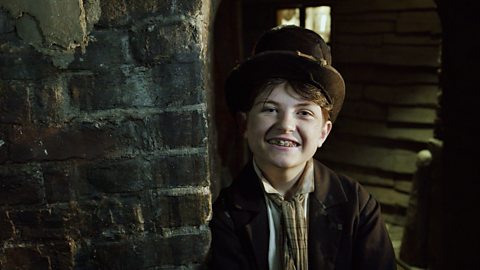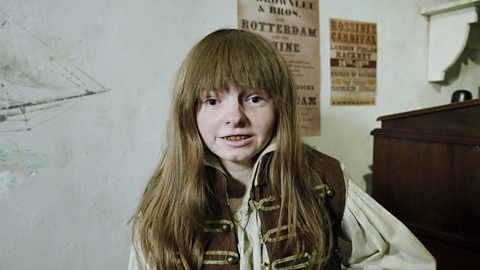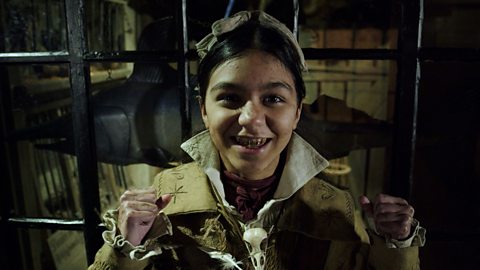TOM:
Whatâs your game? Coppers? Crims? Which is it?
My name's Tom. Been in the nick, you know. Escaped didn't I? But I donât like to go on about it.
So you want to know about crime and punishment do ya? Well, hereâs just a few things you can get a prison sentence for in Victorian England⊠Nicking a cucumberâŠ
DODGER:
Nicking a loaf.
POLLY:
One month's hard labour for nicking a quarter of gooseberries.
MORGAN:
You can get whipped, as well as go to jail.
TANG:
There are kids as young as six in prison. Yes, six!
POLLY:
In court, they donât think, "Oh, look at that poor kid, he must be really desperate to nick that." Nah, no chance.
DODGER:
Things did get a bit better in 1847 with the Juvenile Offenders Act.
CHARLEY:
If you were under 14, you'd be tried in a special court, not an adult one.
TOM:
They're building new prisons all the time. The well off, they want us all banged up.
DODGER:
They think prison will stop me doing it again. But when your stomach's growling and you're desperate for a crumb. Youâre gonna nick it, ain't ya?
TOM:
In prison, they make adults climb the treadwheel. It's this big wheel that you climb up eight hours a day, ten minutes on, five minutes off. They call it the never-ending staircase.
CHARLEY:
You think that's bad? The crankâs worse. The crankâs this big stiff handle that you turn hundreds of times just to get your dinner, over and over, till you feel like your armâs going to drop off.
TANG:
Sometimes instead of being sent to prison, you get sent to Australia.
TOM:
But it ain't like the Australia you're thinking of. It's a prison camp. Transportation they call it. When you get there, you'll live in a barracks with all the other inmates, and you work all day building roads or sweating on a farm away from everyone and everything you know. And even though you might get a seven year sentence and you're free at the end of it, how are you going to get back? Swim?
DODGER:
Better not get nicked then eh? Run!
Video summary
In this short film for primary schools Dodger and the gang provide a brief guide to crime and punishment in Victorian Britain.
They list a few examples of things you could get sent to prison for in Victorian Britain, including stealing gooseberries or a loaf of bread.
Children as young as six could be sent to prison until the 1847 Juvenile Offenders Act meant under 14s would be tried in a special court, not for adults.
The gang describe the gruelling prison punishments including 'The Treadwheel' and 'The Crank', and how some prisoners were sent to camps in Australia, working on roads and farms in the sweltering heat.
This short film is from the ±«Óătv Teach series Dodger's Guide to Victorian Britain.
Teacher Notes
Before watching the film
As the Dodger characters are mainly child criminals, it could give the pupils a mistaken assumption that all Victorian children were criminals. It is important to place this video in the context of the other ones, so the class appreciates that at this time children were also workers and scholars.
In a short video, it is difficult to get the full picture. There is a passing reference to changes made with the 1847 Juvenile Offenders Act, but there is no mention of the fact that from the 1850s onwards, child criminals would be sent to reformatory or industrial schools rather than prisons. Their aim was to teach children a trade so they would not reoffend and, in this regard, they were successful. In fact, research by Barry Godfrey, Professor of Social Justice at University of Liverpool, shows that only 22% of children reoffended whereas the rate today is nearly double that figure.
Questions to consider whilst watching the film
Depending on the focus of your lesson, you may wish to ask the following questions after the video or the pause the short film at certain points to check for understanding.
- Which punishments for crime are the same as today and which are different?
- What changes happened with the Juvenile Offenders Act? What does this tell us about courts and prisons before 1847?
- According to Dodger, what was the main reason why people stole?
- Prisoners spent their time on the treadwheel and the crank. Can you describe these?
- What did we learn about transportation from the video?
- Do you think the Victorians were cruel in their treatment of child criminals?
After watching the film - activities to further explore learning
Concept of historical interpretation - One of the least explored concepts in the primary history classroom is historical interpretation, yet it is one which can provide rich learning experiences for children. There are two strands to this concept and both can be studied through a focus on this Dodger film.
The first strand is historical representations. This is when the focus is on the ways the past has been recreated or re-presented for a modern audience. For many people, history is accessed through novels, films and television. The series Dodger is fictional and based on characters created by the novelist Charles Dickens. This leads us to ask the questions such as how truthful or realistic is this source? How much of the story is made up to make it more interesting for modern audiences?
This idea is explored in one of the Transition Projects developed by primary and secondary teachers, which are freely available on the Historical Association website. One investigation was The lesson plans and resources are available to download. Although the focus is on the earlier workhouse scenes in the story, the structure of the investigation and the questions asked could equally apply to Dodger. Two of the learning objectives can be applied to any recreation of the past:
- That films offer different interpretations through their use of action, colour, music, etc.
- That interpretations differ because of their purpose, audience and the context in which they were produced.
The second strand is historical interpretations. This is where the children explore that there are different opinions for any historical topic and that an historian must look at both sides of the argument before reaching a balanced conclusion.
Another enquiry on the Historical Association website is The focus here is the treatment of children in the Victorian criminal justice system. The first part of the investigation explores the popular opinion that the Victorians were cruel in their treatment of child criminals. This view is shared by the makers of the Dodger film, which could replace the sources used on the website.
This viewpoint can be supported by an exploration of historical sources. There is a wealth of documentary evidence on the experiences of individual children; for example, the National Archives website has an investigation on . If you want to explore this more fully, there is a depth case study of the .
The second part of the enquiry challenges the view of the Victorians as cruel by presenting contrary evidence. There were many Victorians who campaigned for better treatment of prisoners. One of these was the prison reformer Elizabeth Fry. There is a ±«Óătv Bitesize video about her; although designed for KS1 children, it will provide essential information for your class and will show that not all Victorians were cruel.
What is not explored in this transition project is the change away from prisons to reformatory or industrial schools. The ±«Óătv Teach website has a series of videos on âyoung Victorian villainsâ, and one of these focuses on reformatory schools and another on industrial schools. Each of the videos has accompanying teacher notes. These schools were strict by modern standards, but the aim was âto teach young criminals a trade and stop them re-offending.â As mentioned above, they were successful and this suggests that the Victorians were not as cruel as initially portrayed and were attempting to improve the lives of criminal children.
Any classroom work on historical interpretations needs to assess the pupilsâ ability to present both sides of an argument and then to come to their own opinion on a question. This can be done in several ways, either as a piece of extended writing or through a simulation of a television documentary with presenters, reporters and people being interviewed.
England
From the History national curriculumPupils should:
- understand historical concepts ⊠and use them to make connections, draw contrasts, analyse trends, frame historically-valid questions and create their own structured accounts, including written narratives and analyses.
- discern how and why contrasting arguments and interpretations of the past have been constructed.
Northern Ireland
From the statutory requirements for Key Stage 2: The World Around UsPupils should be enabled to explore:
- Some of the characteristics of past societies and distinctive features of life in the past.
Links can be made with the other Learning Areas:
- Language and Literacy by researching and expressing opinions and ideas about people and places in the world around us, past, present and future.
- Personal Development and Mutual Understanding by comparing and contrasting the experiences and feelings of other people in other places and times.
Scotland
From the Experiences and Outcomes for planning learning, teaching and assessment of Second Level Social Studies
- I can use primary and secondary sources selectively to research events in the past.
- I can interpret historical evidence from a range of periodsâŠ
Wales
From the new Humanities Area of Learning and ExperienceSchool curriculum design for History should:
- develop historical interpretation, understanding and source-based skills.
- develop rich content across the time periods, through which learners can develop an understanding of chronology through exploring⊠interpretations.
- expose learners of all ages to a range of historical periods on a local, national and global scale.
Principles of progressionDescriptions of learning for Progression Step 2
Enquiry, exploration and investigation inspire curiosity about the world, its past, present and future:
- I have been curious and made suggestions for possible enquiries and have asked and responded to a range of questions during an enquiry.
- I have experienced a range of stimuli, and had opportunities to participate in enquiries, both collaboratively and with growing independence.
Events and human experiences are complex, and are perceived, interpreted and represented in different ways:
- I can recognise and explain that my opinions and the opinions of others have value.
- I can recognise that opinions may change over time.
Dodger's guide to being a Victorian kid. video
In this short film for primary schools Dodger and the gang provide a brief guide to life for children in Victorian Britain, including some of the ways in which children were employed.

Dodger's guide to poverty and the workhouse. video
In this short film for primary schools Dodger and the gang provide a brief guide to the Victorian workhouse and the common diseases from the time, particularly cholera.

Dodger's guide to key inventions. video
In this short film for primary schools Dodger and the gang provide a guide to those inventions from the Victorian era which changed lives then and now.

Dodger's guide to Victorian London. video
In this short film for primary schools Dodger and the gang provide an introduction to Victorian London which was, at that time, the biggest city in the world.
